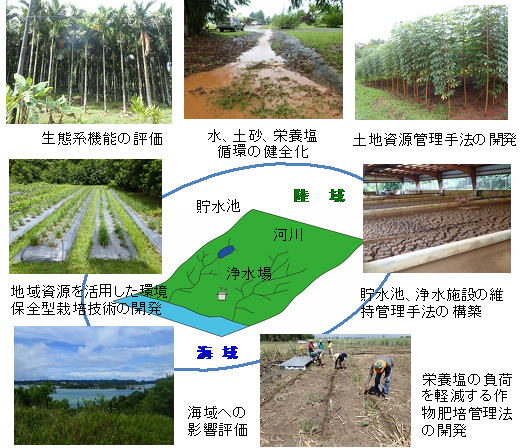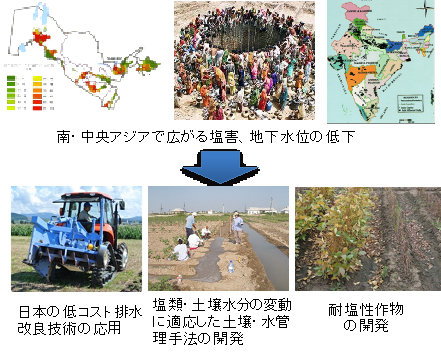“Resource Management in Asia and Pacific Islands” Development of sustainable resource management systems in the water-vulnerable areas of Asia and the Pacific Islands
2017-10-23
アジア・太平洋島嶼水利用制限地域における資源保全管理技術の開発(アジア・島嶼資源管理)
世界の年間の降水量(3.9兆トン)のうち、約7割が農業用水として使用されており、農業用水の7割がアジアで使用されています。世界人口の増加とそれに伴う穀物消費の増加が進む中、「地球公共財」である水資源を持続的に守り、変動の大きな地域で、農業生産に効率的に使用する必要があります。そこで、農業用水の使用が多いアジア・太平洋島嶼の自然環境の異なる地域から、ウズベキスタン、北インド、バングラデシュの塩害・乾燥地域と、フィリピン、パラオの湿潤・島嶼地域を選び、それぞれの地域に適した資源保全管理技術を開発・提案することを目指し、以下の項目について研究を行っています。 湿潤・島嶼地域では、a)森林から沿岸水域における生態系機能、河川流域から流出する水、土砂、栄養塩の影響、気候変動や流域土地利用の改変の影響を試算・評価します。また貯水池流域の水・物質収支や水資源量を評価し、浄水場の沈殿池で発生した堆砂を再利用するシステムを構築します。次にb)河川への土砂、栄養塩の流出を防止する果樹等作物の栽培技術を開発するとともに、農作物、果樹、森林、水産資源、地下水等の有効活用化を図ることを通して、環境保全に配慮した土地・資源管理手法を開発・提案します。さらにc)島嶼を代表とする土壌を対象とし、土壌中の溶質移動モデルと作物モデルの適用を通して、農業由来の栄養塩の地下流出を軽減し、作物の持続的な生産を可能にする肥培管理法を開発・提案します。 乾燥・塩害地域では、a)水田の汎用利用に開発された日本の低コスト排水改良技術を応用し、乾燥地特有の塩類・土壌水分の変動に適応した土壌・水管理手法を開発・提案します。排水改良技術には外部資金で実施中の浅層暗渠等を活用します。次にb)JIRCASが開発した耐塩性遺伝子Nclを現地の品種へ導入し、耐性育種系統を育成します。その後、現地でダイズ育種を展開し、現地に適した耐性育種系統を育成します。


